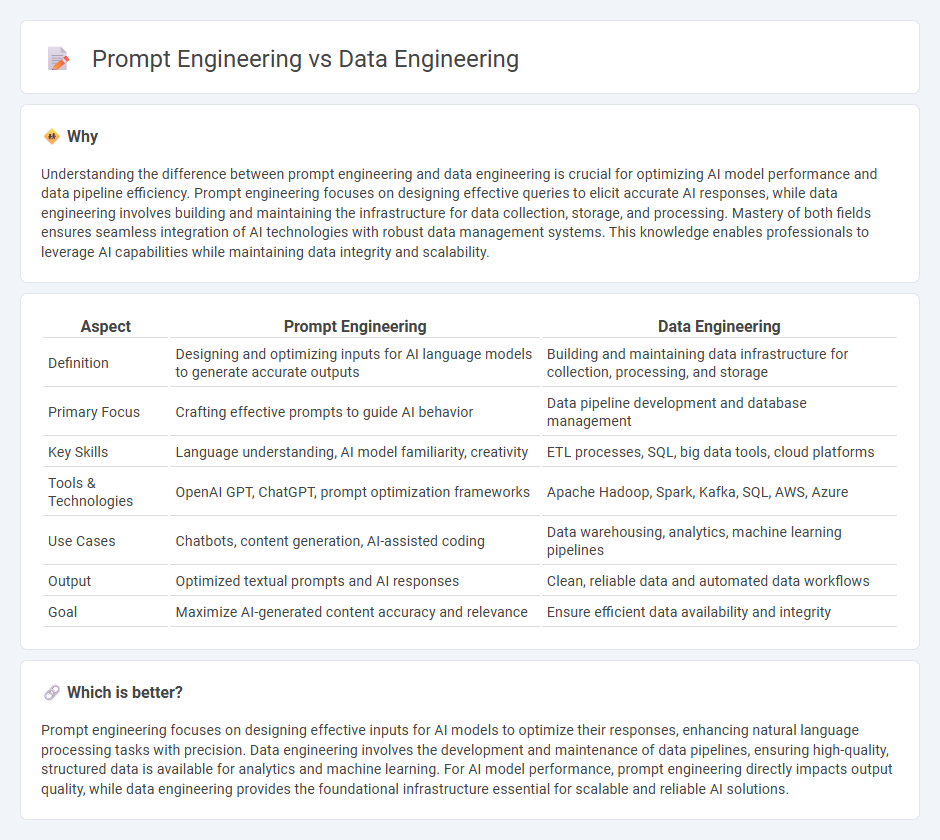
Prompt engineering focuses on designing and refining inputs to optimize AI model responses, leveraging natural language processing and machine learning techniques. Data engineering involves building and maintaining data infrastructure, ensuring efficient data collection, storage, and transformation for analytics and AI applications. Explore the distinct roles and skills that define prompt engineering and data engineering to understand their impact on technology innovation.
Why it is important
Understanding the difference between prompt engineering and data engineering is crucial for optimizing AI model performance and data pipeline efficiency. Prompt engineering focuses on designing effective queries to elicit accurate AI responses, while data engineering involves building and maintaining the infrastructure for data collection, storage, and processing. Mastery of both fields ensures seamless integration of AI technologies with robust data management systems. This knowledge enables professionals to leverage AI capabilities while maintaining data integrity and scalability.
Comparison Table
| Aspect | Prompt Engineering | Data Engineering |
|---|---|---|
| Definition | Designing and optimizing inputs for AI language models to generate accurate outputs | Building and maintaining data infrastructure for collection, processing, and storage |
| Primary Focus | Crafting effective prompts to guide AI behavior | Data pipeline development and database management |
| Key Skills | Language understanding, AI model familiarity, creativity | ETL processes, SQL, big data tools, cloud platforms |
| Tools & Technologies | OpenAI GPT, ChatGPT, prompt optimization frameworks | Apache Hadoop, Spark, Kafka, SQL, AWS, Azure |
| Use Cases | Chatbots, content generation, AI-assisted coding | Data warehousing, analytics, machine learning pipelines |
| Output | Optimized textual prompts and AI responses | Clean, reliable data and automated data workflows |
| Goal | Maximize AI-generated content accuracy and relevance | Ensure efficient data availability and integrity |
Which is better?
Prompt engineering focuses on designing effective inputs for AI models to optimize their responses, enhancing natural language processing tasks with precision. Data engineering involves the development and maintenance of data pipelines, ensuring high-quality, structured data is available for analytics and machine learning. For AI model performance, prompt engineering directly impacts output quality, while data engineering provides the foundational infrastructure essential for scalable and reliable AI solutions.
Connection
Prompt engineering and data engineering intersect through their focus on optimizing data utilization for artificial intelligence systems; prompt engineering designs effective input queries while data engineering ensures the collection, transformation, and storage of high-quality datasets. Both fields rely on structured data pipelines and natural language processing techniques to enhance AI model performance and accuracy. Integrating prompt design with robust data infrastructure significantly improves machine learning outcomes and real-time decision-making capabilities.
Key Terms
**Data Engineering:**
Data engineering involves designing, building, and maintaining scalable data pipelines and storage solutions to ensure efficient data processing and accessibility for analytics and machine learning. It emphasizes data integration, transformation, and quality management across diverse sources using tools like Apache Spark, Hadoop, and ETL frameworks. Explore more to understand the critical role data engineering plays in unlocking data-driven decision-making.
ETL (Extract, Transform, Load)
Data engineering centers on designing and maintaining ETL pipelines to efficiently extract data from multiple sources, transform it into usable formats, and load it into data warehouses for analysis. Prompt engineering focuses on crafting effective prompts to optimize AI models' responses, playing a lesser role in direct data processing tasks like ETL. Explore deeper insights into how ETL processes differentiate these two fields and their impact on data workflows.
Data Pipeline
Data engineering centers on designing, building, and maintaining robust data pipelines that efficiently collect, transform, and store large volumes of data for analysis. Prompt engineering, by contrast, involves crafting precise inputs for AI models to generate desired outputs, with less emphasis on data pipeline infrastructure. Explore how each discipline optimizes data workflows and AI interactions to enhance your technological strategy.
Source and External Links
What Is Data Engineering? | IBM - Data engineering is the practice of designing and building systems for the aggregation, storage, and analysis of data at scale to empower organizations with real-time insights from large, diverse datasets.
Data engineering - Wikipedia - Data engineering is a software engineering discipline focused on building systems that enable the collection and usage of data, typically to support analysis, data science, and machine learning, often using high-performance computing and dataflow programming tools.
What Is Data Engineering? | Informatica - Data engineering involves discovering, designing, and building data infrastructure to process raw data from multiple sources, making it usable for critical business decisions through practices like ETL, data modeling, and metadata management.
 dowidth.com
dowidth.com